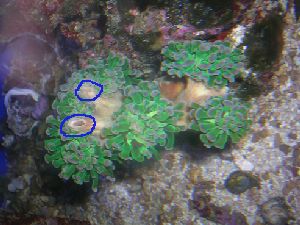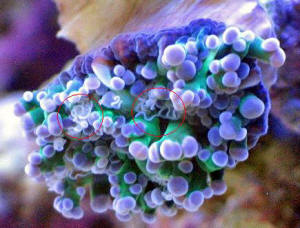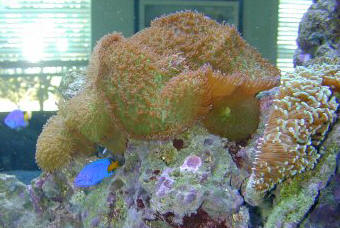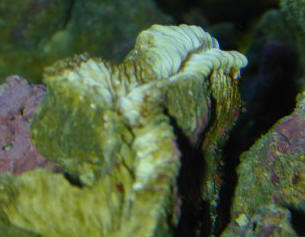|
FAQs about Caryophyllid Coral Disease, Pests, Predation 3
Related
Articles:
Coral Pests and
Disease; pests, predators, diseases and conditions by Sara
Mavinkurve, Caryophyllid
Corals, Elegance
Coral,
FAQs on Euphylliid Disease:
Caryophyllid Disease 1, Caryophyllid Disease 2,
Caryophyllid Disease 4, Caryophyllid Disease 5, Caryophyllid Disease 6, Caryophyllid Disease 7, Euphylliid Health 8, Euphylliid Health 9, Euphylliid Health 10, &
Elegance Coral Disease/Pests,
FAQs on Euphylliid Disease by Category:
Diagnosing,
Environmental (Pollution/Poisoning, Lighting...),
Nutritional, Social (Allelopathy),
Trauma,
Pathogenic (Infectious, Parasitic, Viral)
Predatory/Pest, Treatments
FAQs on Stony Coral Disease by Category: Diagnosing,
Environmental (Pollution/Poisoning, Lighting...),
Nutritional, Social (Allelopathy),
Trauma,
Pathogenic (Infectious, Parasitic, Viral)
Predatory/Pest,
Treatments
&
Caryophylliids 1, Caryophylliids 2, Caryophylliids 3, Caryophylliids 4, Caryophyllid ID, Caryophyllid Compatibility, Caryophyllid Systems, Caryophyllid Selection, Caryophyllid Behavior, Caryophyllid Feeding, Caryophyllid
Propagation/Reproduction,
|

|
Frogspawn health 4/14/06
Hello
Crew,
<Edward>
Help, my frogspawn hasn't come out since last Fri. It still has
all of its color and doesn't have brown jelly. My water params.
on Sat. were:
pH: 7.9
calc: 390
alk: 8.4 dKH
mag: 1140
sg: 1.025
phos: 0
amm: 0
trite: 0
trate: 0
<These numbers are all okay, but...>
I had several corals that withdrew their polyps for a couple of
days so I checked for everything. I found a leak in my tank and my
top-off worked overtime. My sg went from 1.026 to 1.024 by Thurs.
By Fri. I had my sg back up to 1.025. All the other corals are back
to normal but the frogspawn has not come out at all. I have noticed
the white things circled in the pic and can not figure out what
they are. I can't tell whether it's a worm of some type or
just the tissue folded up on itself.
<... Mmm, these look like a problem to me... perhaps predatory
Nudibranchs...>
Should I dip this coral? Wait it out? Or is it too late?
<Not too late. I definitely would dip this colony. In water of
slightly reduced spg. with a triple dose of Lugol's applied to
it... for fifteen minutes... and I would siphon out these
"worm like" creatures if you see them again>
Any help would be appreciated. Thanks.
<Do read the coverage on the Caryophylliidae posted on WWM. Bob
Fenner> |
|

|
Hammer Coral
Sickness? Death 4/6/06
Hello,
I am having a big problem with my work's fish
tank. We have had this hammer coral for over a
year.
We have no nitrates, nitrites, ammonia, or phosphates in the
water. The PH is always a little low (between 7.9 and
8.1) but the tank has always been like that even after adding lots
of PH balance.
<? Something else wrong here... insufficient water changes, poor
salt mix, not enough soluble substrates, too much
feeding...>
And it has never seemed to hurt anything.
<Operative word: "seemed">
About 4 months ago about 25% of the hammer coral shriveled up and
has never come back.
<It's gone>
The rest of the hammer then started to grow, but now I came into
work to find it receded into the exoskeleton and it was covered in
a white fuzzy covering. And this morning it was totally
gone.... I am at a frantic loss. Here is a before pic
and an after pic. In the before pic the hammer is to the
far right. Any advice would be so
helpful. Thank you for your time.
Desiree
<... Please read here: http://wetwebmedia.com/caryophyllids.htm
and the linked files above... You don't offer sufficient info.
to make good guesses at what has gone on, not gone on here, but by
reading others circumstances, you'll likely bring to your
awareness... Bob Fenner> |
|
 
|
Rapidly dying torch coral 3/17/06
Hello and I appreciate
your help very much. Over the period of one night my torch
coral appears to have lost over half of its heads and instead there is
a brown filmy material there. Should I break off the rest of
the coral that appears to be doing good or is it possible that these
heads will reappear magically? We added a wavemaker to the
tank the other day, but it was turned off over night during this
decline. Could this be the reason for this
loss? My roommate, however believes that the coral has just
retracted to eat since he fed them yesterday. That is the
only major change to the tank. What is your advice or
opinion?
<<This is "brown jelly" disease. The
affected heads should be removed immediately. You may even
want to siphon the dead tissue away before moving the
colony. I would also suggest adding some carbon to the
system if possible. The unaffected heads may be OK and
removing the affected ones will definitely help. Best
Regards. AdamC.>>
Euphyllia divisa/frogspawn - 03/13/2005
Hi all
I just wondering whether what I'm doing here is right or wrong.
I have a mature 100 gallon tank with live rock and sand, 2*150 watt
metal halide XM 20000 kelvin plus 2*38 watt actinic lamp (I wonder if
the light is too much or not with the Euphyllia)
<Is not>
plus 1 protein skimmer, chiller. Live stock: the angelfishes (blue
face, flame)
<The first gets too big for this system>
and also I have 1 green Euphyllia divisa/frogspawn and 1 ancora and
green star polyps. Everyday I feed the fish with the blended frozen
meaty food (from marine origin) in the morning (just only once a day),
I just wonder if this is too much
with the fish and the invertebrates or not?
<Not likely... your water quality tests would show if so>
How am I gonna meet the proper feeding strategy for both (the fish and
the invertebrates such as Euphyllia divisa)?
<Read... on WWM re...>
Because I have lost already 2 green Euphyllia ancora... suddenly it
never open the polyps and
death (takes only 2 months since I have it) I just don't want to
get lost anymore with my Euphyllia. Now I got stressed with the
Euphyllia!!
<... likely water quality issue>
(I've read your article in WWM and follow the instruction about
Euphyllia: no need high water flow, light: medium (I think), and placed
in the bottom (the sand)
Weekly I add the strontium, iodine, calcium & magnesium and change
the water every month for 40%.
Note: my angelfishes are never nipping the Euphyllia if they are fully
expanded, they just nipping the rock (under the polyp of the Euphyllia
has the fleshy skin that angels like it, and I don't know what is
that)
Thanks for your help
Best regards
Ignatio
<Take a read re the families needs for biomineral, alkalinity... It
may be that you just got/had "bunk" specimens... Perhaps
there is an inherent allelopathy at play here... Bob Fenner>
Seeking advice for a problem (disease/parasites?)
with my branching hammer coral (Euphyllia parancora)
2/14/06
Hi! I have a beautiful and (so far) healthy branching
hammer coral with metallic green tips. There are even new branches
slowly coming out. I
recently noticed that there were small holes in the skeleton (I mean
the hard non-fleshy part...). Holes have a diameter of about 1mm.
I
verified
with a needle (with caution) to be sure they were not just dark spots
giving the false impression there were holes but they really are holes.
In two
places the holes are much larger (many small holes done next to
another?) making those spots look like a piece of cheese...
<Good description>
The night before I noticed hundreds of small oval shaped 1mm creatures
crawling everywhere in the tank
(glass, LR, and LPS corals). They are not flat, really like tiny little
whitish walking eggs. They don't look like the typical copepod. I
also have
some copepods and really I don't think these are. They walk in a
somehow clumsy way and not in a gastropod's fashion. Sometimes they
just release
hold and let themselves go away with the current. Even tough very small
I think I can see eyes gleaming when I use the flashlight (as with
mysids) so
they could be crustaceans. I took one and tried to see better with a
magnifying glass but I couldn't see more details. Unfortunately I
don't have
access to a microscope right now. I didn't see any of them actually
entering/exiting a hole so I can't even conclude they are related
to the problem.
<Not likely>
Is it even possible that these holes were there since I got the coral
but that I never noticed. I don't think so, but since I didn't
take any
pictures... Of course now comes the paranoia and I am under the
impression that the coral's fleshy base was whiter than it is now.
Looks a bit brownish
to me under the flashlight (it's subtle...).
<This is no worry>
I am worried for my corals, I have other beautiful Euphylliids in the
tank and I don't want to loose them.
<Or lose them>
I know it's probably not an easy question.
Thanks for any advice!
Dominique
<The empty areas are very likely due to your water quality...
Something out of balance... biomineral (calcium, or magnesium
percentage) and alkalinity... check these and fix. Along with feeding,
sufficient light, good care, these should go in time. The
"bugs?"... I'd ignore them for now. Bob Fenner>
Euphyllia issues - 1/6/06
I am having a problem with
several species of Euphyllia corals in 2 of my 3 tanks. Both tanks are
primarily Acropora "themed" but have a few LPS specimens for
some flow and flash. My problems started in my 210 with a very large
hammer coral I have had for about 15 years. It WAS about the size of a
basketball until recently. In several places the coral has started to
peel from the skeleton in the corners. I have seen this before and have
read that it is frequently caused by strontium deficiency.
<Strontium and Moly are a must.> Every other time I have seen it,
(not in this specimen however, I work in an aquarium store and see it
occasionally in customers tanks) it has looked more like the flesh just
peeling out cleanly but this is rotting as it peels out and very slowly
and in small sections. It seems to stop for awhile,
heal, and then resume again periodically. No jellying has
been seen. This has been going on for a couple months, the colony now
about 2/3 its peak size. Now just within the last week or so 2 other
pieces in another tank, a 135, have just stopped expanding and have
remained closed. I see no peeling or decay but they are shut up tight.
These specimens are also about 15 years old. Tonight I came home and a
small torch, a paradivisa I believe, in the 210 is just gone. The only
thing that has changed, and it was about the same time, were I did a
SLIGHTLY larger water change than normal, I was setting up a new tank
and wanted to use this water. I typically do about 10-15% changes a
month and I did about 25-30% on this occasion. <Shouldn't cause
the problem> I did also change the brand of calcium I was using, I
have since changed back just in case. All other corals, mostly SPS and
a few leathers look phenomenal. Both tanks are set up in similar
fashion....both have Berlin style sumps, Euro reef skimmers, cal
reactors (which can't keep up hence the additional supplements)
halide / VHO lighting and heavy water flow. <The Euphyllia family
prefers moderate water flow.> Chemistry ..... Ammonia & nitrite
0 of course, Nitrate a trace, KH 12-15, calcium 380-420, Magnesium
about 1200, temp 77. <You didn't mention SG, should be kept at
1.024/25 for corals.> I only have a few fish and feed very
sparingly. Since these are more turbid water corals is it possible I am
starving them? <They do benefit from weekly feeding of DT's
and/or Cyclop-Eeze plankton, etc.> I have never directly fed them
but why would they have a problem with that now? <Don't know>
I use phytoplankton rarely on the order of perhaps once a
week.<That's not rarely, recommended> Is it possible they
didn't like the new brand of calcium?
<Unlikely> On the off chance there was some thing in
it they didn't care for I did put in fresh carbon and poly filters
but if its a nutrient deprivation that could have made it worse. I did
change the VHO bulbs about 4 weeks ago. Halides are about 10 months old
and due. These specimens are located on the ends of the tank and lower
down so they aren't getting blasted by the flow. Enough to move the
tentacles but far from whipping in the wind. Sorry for being so long
winded. Any help would be greatly appreciated. I have had these guys a
long time and hate to lose them. <You may want to dose trace
elements on a weekly basis. Poly Filters, carbon can remove
some of these. helps you I like keeping a
log on my system, noting everything done whether a change in flow rate,
salinity, chemical media, lighting, etc. Then if something
changes I can go back and see if it relates to anything I've
changed/added. Hope this helps you out
some. James (Salty Dog)> Mike Knight, Tampa
FL.
Euphyllia Issues - 1/6/06
Mike, several hours after
I answered your query I thought of another possible
fix. Most species in the Euphyllia family extend sweeper
tentacles during the evening extending as much as six
inches. If the corals are closer than six inches apart they
are probably being stung during the night. This could cause
what you are seeing. Sorry for my
oversight. James (Salty Dog)>
Re: Euphyllia issues 1/7/06
Thank you very
much for answering my question....or at least attempting to,
but it appears that most of the response was cut off somehow. Possible
to
resend? Appreciate it! BTW I am using a strontium supplement
(Kent) as per
manufacturers directions. Not testing however. Should I be? <Mike,
in my opinion, with the amount of corals you have, I don't believe
there is a danger of overdosing strontium if you follow dosing
instructions on the product container. Strontium is used up
rapidly in reef systems. As far as the message being cut
off, I have no idea what happened here. I'm hoping you saved your
original to resend as these messages are deleted after they are sent
and posted. {Bob, correct me if I'm wrong.}
James (Salty Dog)> <<That/this is correct James... no
time/space to save originals. BobF>>
|

|
Hammer Coral With Feather Worms? - 11/25/05
Hi Bob,
Anthony, crew,
<<Crewmember EricR here tonight.>>
These holes in my hammer coral contain a feather worm of some
type?
<<Are you asking me? I've seen this before in
various corals (usually Porites), though never before in a Hammer
Coral.>>
There is also one hidden in the branch head below in the
middle.
<<ok>>
Sent an earlier email in regard to why my hammer withdraws as the
day goes on. Could these be the culprits?
<<Possibly...most corals show a tolerance for these
worms...but there's always the exception.>>
If so should I eliminate them and how?
<<Up to you... If you think they are causing the
hammer to decline and you wish to keep it over the worms, then yes,
you'll probably have to remove/kill them.>>
Thanks,
Have a Happy Thanksgiving.
Tom
<<Regards, EricR>> |
Coral Question 11/17/05
Hello Crew, You have always
been very helpful and kind in the past and I hope you might help me
with this coral. I was separated from my tank for 4 days after having
my tonsils taken out. My tank was left in the care of a friend who
basically just fed the fish. When I returned, I noticed that one of my
corals appeared to be in some trouble. I have attached a picture to
show you exactly what is going on. I have had this coral for about 2
months and all the branches have been very full and healthy.
The left branch shown by the arrow in the picture was almost completely
gone when I returned, meaning he died out within 4 days. The branch on
the right is also leaving very quickly. The only thing unusual I
noticed was a little bit of cotton like substance on the completely
dead branch. Any ideas would be greatly
appreciated.
Thank You
<Does read and look like something pathogenic. As time is of the
essence here, I would go ahead and "frag" (basically, break
off the healthy section/s and toss the declining, and if you have
another up and going system, place the remaining part there... there is
some value in a dip of iodine/ate and lowered spg... These are covered
on WWM: http://www.wetwebmedia.com/carydisfaqs.htm
and the linked files above. Bob Fenner>
|
|

